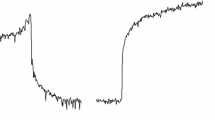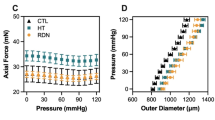Abstract
The biomechanical adaptation of the arterial wall to hypertension has been studied extensively in recent years; however, the exact biomechanical contribution of vascular smooth muscle cells (VSMCs) during the adaptation process in conduit vessels is not known. We induced hypertension in 8 wk old Wistar rats by total ligation of the aorta between the two kidneys. Mean blood pressure increased from 92 ± 2 (mean ± SE)mm Hg to approximately 150 mm Hg. Rats were sacrificed 2, 4, and 8 d after surgery and the left common carotid artery was excised for analysis. Wall thickness increased by 18% in 8 d and the opening angle by 32% in 4 d. The elastic properties were measured under normal VSMC tone (i.e., the amount of VSMC tone under normal conditions also called basal VSMC tone or normal resting VSMC tone), under maximally contracted VSMC (NE, 5 × 10 -7mol/L) and under totally relaxed VSMC conditions (papaverine, 10-4 mol/L). The most pronounced modifications were the changes in elastic properties related to normal VSMC tone. The functional contraction ratio at 100 mm Hg, defined as the relative contraction under normal conditions (normal VSMC tone), increased by 439% 4 d after the induction of hypertension. The total contraction capacity of the VSMC increased by 38% within 8 d. The changes in normal VSMC tone led to important changes in the mechanical properties of the arterial wall. Under normal VSMC conditions, compliance at mean pressure (148 mm Hg) increased by 159% within 8 d, whereas in the absence of VSMC tone, compliance did not increase significantly. We conclude that in conduit vessels, the VSMC, which is the sensing and effecting element of the adaptation process, is subjected to large-scale changes during the early phase of arterial adaptation to acute hypertension. © 2001 Biomedical Engineering Society.
PAC01: 8719Rr, 8719Ff, 8719Uv, 8717-d
Similar content being viewed by others
REFERENCES
Asano, M., K. Masuzawa-Ito, and T. Matsuda. Charybdotoxin-sensitive K+ channels regulate the myogenic tone in the resting state of arteries from spontaneously hypertensive rats. Br. J. Pharmacol. 108:214–222, 1993.
Begum, N., Y. Song, J. Rienzie, and L. Ragolia. Vascular smooth muscle cell growth and insulin regulation of mitogen-activated protein kinase in hypertension. Am. J. Psychol. 275:C42–C49, 1998.
Cox, R. H. Alterations in active and passive mechanics of rat carotid artery with experimental hypertension. Am. J. Psy-chol. 237:H597–H605, 1979.
Cox, R. H. Comparison of arterial wall mechanics in normotensive and spontaneously hypertensive rats. Am. J. Psychol. 237:H159–H167, 1979.
Davis, M. J., and M. A. Hill. Signaling mechanisms underlying the vascular myogenic response. Physiol. Rev. 79:387–423, 1999.
Dolbrin, P. Vascular mechanics. In: Handbook of Physiology, Sec. 2, The Cardiovascular System, edited by A. F. Shepherd, Bethesda, MD: JT, Geiger, SR, 1983, pp. 65–102.
Dzau, V. J., and G. H. Gibbons. Cell biology of vascular hypertrophy in systemic hypertension. Am. J. Cardiol. 62:30G–35G, 1988.
Folkow, B. Structure and function of the arteries in hypertension. Am. Heart J. 114:938–948, 1987.
Fung, Y. Biomechanics: Motion, Flow, Stress and Growth. New York: Springer, 1990, 569 pp.
Garcia, S. R., A. S. Izzard, A. M. Heagerty, and S. J. Bund. Myogenic tone in coronary arteries from spontaneously hypertensive rats. J. Vasc. Res. 34:109–116, 1997.
Grande, J. P., S. Glagov, S. R. Bates, A. L. Horwitz, and M. B. Mathews. Effect of normolipemic and hyperlipemic serum on biosynthetic response to cyclic stretching of aortic smooth muscle cells. Arteriosclerosis (Dallas) 9:446–452, 1989.
Greenwald, S. E., D. L. Newman, and H. T. Denyer. Effect of smooth muscle activity on the static and dynamic elastic properties of the rabbit carotid artery. Cardiovasc. Res. 16:86–94, 1982.
Hansen-Smith, F., A. S. Greene, A. W. Cowley, Jr., L. Lou-gee, and J. H. Lombard. Structural alterations of microvascular smooth muscle cells in reduced renal mass hypertension. Hypertension 17:902–908, 1991.
Hayoz, D., Y. Tardy, B. Rutschmann, J. P. Mignot, H. Achakri, F. Feihl, J. J. Meister, B. Waeber, and H. R. Brunner. Spontaneous diameter oscillations of the radial artery in humans. Am. J. Psychol. 264:H2080–H2084, 1993.
Heagerty, A. M., C. Aalkjaer, S. J. Bund, N. Korsgaard, and M. J. Mulvany. Small artery structure in hypertension. Dual processes of remodeling and growth. Hypertension 21:391–397, 1993.
Langile, B. Blood flow-induced remodeling remodeling of the artery wall. In: Flow-Dependent Regulation of Vascular Function, edited by K. G. Bevan and J. A. Rubanyi, New York: Oxford University Press, 1995.
Laurent, S. Arterial wall hypertrophy and stiffness in essential hypertensive patients. Hypertension 26:355–362, 1995.
Lee, R. M., G. K. Owens, T. Scott-Burden, R. J. Head, M. J. Mulvany, and E. L. Schiffrin. Pathophysiology of smooth muscle in hypertension. Can. J. Physiol. Pharmacol. 73:574–584, 1995.
Liu, S. Q., and Y. C. Fung. Relationship between hypertension, hypertrophy, and opening angle of zero-stress state of arteries following aortic constriction. J. Biomech. Eng. 111:325–335, 1989.
Liu, Z. R., C. T. Ting, S. X. Zhu, and F. C. Yin. Aortic compliance in human hypertension. Hypertension 14:129–136, 1989.
Matsumoto, T., and K. Hayashi. Mechanical and dimensional adaptation of rat aorta to hypertension. J. Biomech. Eng. 116:278–283, 1994.
Matsumoto, T., M. Tsuchida, and M. Sato. Change in intramural strain distribution in rat aorta due to smooth muscle contraction and relaxation. Am. J. Psychol. 271:H1711–H1716, 1996.
Michel, J. B., A. Bardou, A. Tedgui, and B. Levy. Effect of descending thoracic aorta clamping and unclamping on phasic coronary blood flow. J. Surg. Res. 36:17–24, 1984.
Mulvany, M. J. Peripheral vasculature in essential hypertension. Clin. Exp. Pharmacol. Physiol. 23:S6–S10, 1996.
Murphy, R. Mechanics of vascular smooth muscle. In: Hand-book of Physiology, Sec. 2: The Cardiovascular System, edited by D. Bohr, A. Somlyo, and H. Sparks, Jr. Bethesda, MD: American Physiological Society, 1980, pp. 325–353.
Osol, G. Mechanotransduction by vascular smooth muscle. J. Vasc. Res. 32:275–292, 1995.
Rachev, A. Theoretical study of the effect of stress-dependent remodeling on arterial geometry under hypertensive conditions [see comments]. J. Biomech. 30:819–927, 1997.
Reusch, P., H. Wagdy, R. Reusch, E. Wilson, and H. E. Ives. Mechanical strain increases smooth muscle and decreases nonmuscle myosin expression in rat vascular smooth muscle cells. Circ. Res. 79:1046–1053, 1996.
Rusch, N. J., T. A. Wooldridge, G. N. Olinger, and L. E. Boerboom. The effect of ambient temperature on papaverine-induced relaxations in canine saphenous veins. J. Thorac. Cardiovasc. Surg. 104:1289–1293, 1992.
Stacy, D. L., and R. L. Prewitt. Effects of chronic hypertension and its reversal on arteries and arterioles. Circ. Res. 65:869–879, 1989.
Vaishnav, R. N., J. Vossoughi, D. J. Patel, L. N. Cothran, B. R. Coleman, and E. L. Ison-Franklin. Effect of hypertension on elasticity and geometry of aortic tissue from dogs. J.Biomech. Eng. 112:70–74, 1990.
Weber, R., N. Stergiopulos, H. R. Brunner, and D. Hayoz. Contributions of vascular tone and structure to elastic properties of a medium-sized artery. Hypertension 27:816–822, 1996.
Zanchi, A., N. Stergiopulos, H. R. Brunner, and D. Hayoz. Differences in the mechanical properties of the rat carotid artery in vivo, in situ, and in vitro. Hypertension 32:180–185, 1998.
Author information
Authors and Affiliations
Rights and permissions
About this article
Cite this article
Fridez, P., Makino, A., Miyazaki, H. et al. Short-Term Biomechanical Adaptation of the Rat Carotid to Acute Hypertension: Contribution of Smooth Muscle. Annals of Biomedical Engineering 29, 26–34 (2001). https://doi.org/10.1114/1.1342054
Issue Date:
DOI: https://doi.org/10.1114/1.1342054




